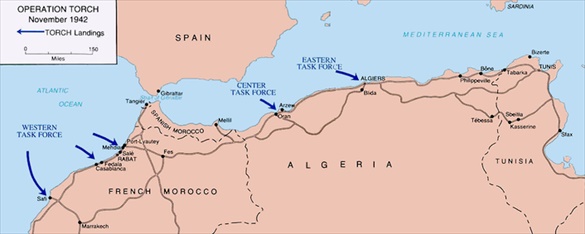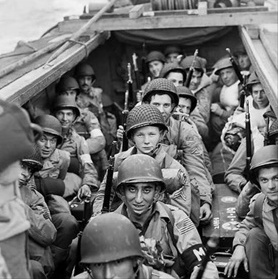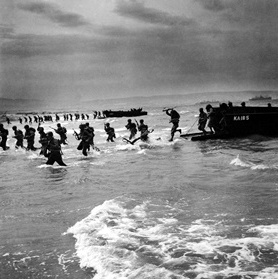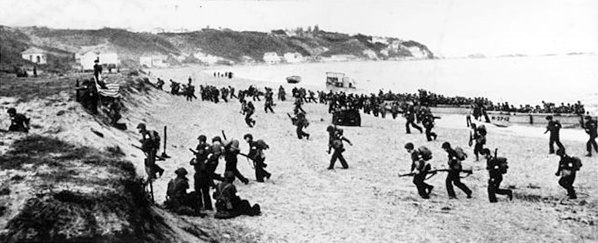ALLIES ESTABLISH PRESENCE IN FRENCH NORTH AFRICA
Gibraltar Mediterranean Forward Operating Base • November 8, 1942
Within four weeks of the massive German invasion of the Soviet Union on June 22, 1941 (Operation Barbarossa), with Adolf Hitler’s Wehrmacht (German armed forces) easily and quickly advancing on the Soviet capital, Moscow, Soviet leader Joseph Stalin on July 19, 1941, and again in September pressed Great Britain and the still-neutral United States to open a second front in Western Europe to relieve German pressure on the Soviet Union’s rapidly collapsing western frontier (Germany’s eastern front). The most the U.S., as the emerging “arsenal of democracy,” could do in the circumstances was for President Franklin D. Roosevelt to declare the Soviet Union eligible for Lend-Lease aid on November 7, 1941. Factory flood gates opened to disgorge tanks, aircraft, trucks, weapons, food, and other war-related material to Stalin and the Red Army, as well as a $50 million credit advanced by the U.S. government.
Since September 1940 British Prime Minister Winston Churchill was mostly preoccupied by a cat-and-mouse, ultimately successful military campaign against Hitler’s Axis ally, Benito Mussolini, in Italy’s Libyan colony and next-door Egypt. Opening a second major front either in the German-occupied zone of Northern and Western France, increasingly protected by Hitler’s steel-and-concrete Atlantic War, or in the so-called “free zone” of Marshal Philippe Pétain’s collaborationist Vichy France, which bordered the French Mediterranean coast, was not in the realm of possibilities at the moment for either Western democracy. But what about opening an Anglo-American front in Vichy France’s possessions across the Mediterranean in Northwest Africa especially after America formally entered the war against the Axis powers in December 1941? Was that doable and could success be reasonably assured if overwhelming air, sea, and land strength was brought to bear on Vichy French defenders?
Allied military and naval planners identified Casablanca in French Morocco and Oran and Algiers in French Algeria as amphibious landing sites (see map below). Ideally the three sites would be followed by a fourth at Tunis to secure French Tunisia and facilitate the speedy interdiction of troops and material to Field Marshal Erwin Rommel’s German-Italian Afrika Korps in Libya. In the background was the thought that the landings, codenamed Operation Torch, might persuade Pétain to switch allegiance from the Axis to the Allies. Lt. Gen. Dwight D. Eisenhower was placed in overall command of Torch.
Hastily planned in two months’ time, Torch was the largest, most complex, and riskiest military operation yet mounted by the Western powers. Shortly after 1 a.m. on this date, November 8, 1942, the Anglo-Americans sprang their three-prong attack. The assault troops of the Western Task Force encountered unexpected resistance on land and sea, but Casablanca, the principal Vichy French Atlantic naval base, was in Allied hands on November 11. The Center Task Force encountered more resistance than the Western Task Force had met; nevertheless, on November 10 Oran’s commanders surrendered the city. At Algiers, the Eastern Task Force met less opposition because Free French fighters had neutralized the coastal batteries, so Allied ground forces disembarking from landing craft were able to push inland and compel the capital’s surrender by 6 p.m. the first day.
On November 11 Adm. Jean François Darlan, commander in chief of Vichy armed forces who by happenstance was in Algiers during Operation Torch, broke with his boss, Marshal Pétain, and signed an armistice with the Allies. Two days later the Allies recognized Darlan as the head of the French civil government in North Africa. The balance of military and political power in North Africa, admittedly on the periphery of Nazi Europe, now swung in the Allies’ favor, where it would stay until May 1943, when the last Axis troops were expelled from their Tunisian stronghold.
![]()
Allied Invasion of Northwest Africa, November 8–16, 1942: First Light in France’s Liberation
 |
Above: Vichy French protectorate of Morocco and Vichy French Algeria, the objectives of Operation Torch. Lt. Gen. Eisenhower (1890–1969) had overall command of the amphibious landings, which involved three task forces, one sailing from the U.S., the other two from England. Commanding the Western Task Force of 33,000 men embarking from the U.S. (target Casablanca) was U.S. Maj. Gen. George S. Patton, Jr. (1885–1945). The Center Task Force of 35,000 men (target Oran, the second largest city in Algeria) was commanded by U.S. Maj. Gen. Lloyd R. Fredendall (1883–1963). The Eastern Task Force of 39,000 American and British troops (target Algiers, the capital city of Algeria) was under the overall command of U.S. Maj. Gen. Charles W. “Doc” Ryder. Operation Torch landed 107,000 U.S. and British troops at nine beachheads along the Moroccan and Algerian coasts, assisted by 350 warships, 500 transports, and heavy air cover. Opposing the North African landings were roughly 125,000 Vichy French soldiers, as well as coastal artillery, 210 tanks, and about 500 aircraft. In addition, there were 10 or so warships and 11 submarines at Morocco. During the eight-day operation, Allied forces suffered well over 1,100 dead and twice that number wounded and missing; Vichy casualties exceeded 1,350 killed, 2,000 wounded, and 400 missing, though the true figures are likely higher.
 |  |
Left: U.S. troops of the 16th Infantry Regiment, 1st Infantry Division on board a landing craft heading for the beaches at Oran in Algeria during Operation Torch, November 8, 1942.
![]()
Right: Allied troops storm an unnamed beach during Operation Torch, November 8, 1942. The Allied amphibious landings in Vichy North Africa, supported by air and naval power, were dress rehearsals for Operation Overlord in June 1944 in Western Europe, ringing the death knell of Hitler’s odious Thousand Year Reich.
 |
Above: Soldiers of the U.S. 34th Infantry Division hit one of three beaches near Algiers behind a large American flag (near left edge of photo but difficult to see), November 8, 1942. The soldiers hoped that the Vichy French defenders would not fire on them as they disembarked from their landing craft and crossed the narrow beach. During the landing shipboard loudspeakers repeatedly blared in French, “Don’t shoot. We are your friends. We are Americans!” Algiers was the first Allied objective in Vichy North Africa to fall.
Operation Torch: The Invasion of French North Africa, November 1942
![]()

 History buffs, there is good news! The Daily Chronicles of World War II is now available as an ebook for $4.99 on Amazon.com. Containing a year’s worth of dated entries from this website, the ebook brings the story of this tumultuous era to life in a compelling, authoritative, and succinct manner. Featuring inventive navigation aids, the ebook enables readers to instantly move forward or backward by month and date to different dated entries. Simple and elegant! Click
History buffs, there is good news! The Daily Chronicles of World War II is now available as an ebook for $4.99 on Amazon.com. Containing a year’s worth of dated entries from this website, the ebook brings the story of this tumultuous era to life in a compelling, authoritative, and succinct manner. Featuring inventive navigation aids, the ebook enables readers to instantly move forward or backward by month and date to different dated entries. Simple and elegant! Click 











